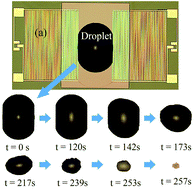Liquid identification by using a micro-electro-mechanical interdigital transducer†
Abstract
A surface-acoustic-mode aluminum nitride (AlN) transducer is utilized to determine the type of liquid dropped on the propagation path. It is based on tracking the shrinking droplet radius and observing stagnant liquid molecules during and after the liquid evaporation process. The device configuration is suitable to test small amounts of liquids, in the microliter range. According to both mass loading and physical property mechanisms, eight samples of liquids, isopropanol (IPA), ethanol (ETH), deionized-water (DW), tap water (TW), heptane (HEP), propylene glycol monomethyl ether acetate (PGMEA), hexamethyldisilazane (HMDS) and acetone (ACE), which have different equilibrium vapor pressures, molecular weights and boiling points, are accurately detected. The experimental results show that the rate of the change in the energy loss including a slow and fast attenuation region depends on the change of physical properties, such as density, sound speed in liquids and evaporation rate, during the evaporation process. As the evaporation rate of the DW is rather slow, the slow attenuation region occurs for a longer time than the fast one. Consequently, the whole oscillation duration of the attenuation occurs for a longer time, whereas that of the other liquids studied, like ACE, ETH, and IPA, having a faster evaporation rate is shorter. Sensitivities of the surface-acoustic-mode transducer to the evaporation process of liquids such as DW, TW, PGMEA, HMDS, HEP, IPA, ETH and ACE are −29.39, −29.53, −31.79, −34.12, −33.62, −32.87, −32.67, and −32.82 dB μm−2, respectively. The concentration of stagnant liquid molecules causes a change in the surface mass of the micro-electro-mechanical transducer, which causes a frequency shift and increases the signal noise at the receiver after the liquid evaporation process. The average frequency shifts of ACE, HEP, HMDS, ETH, IPA, PGMEA, TW and DW are 241, 206, 172, 117, 76, 27.3, 11.6 and 0 kHz, respectively, coherent with the type of formed liquid pattern on the device surface, thus allowing to detect liquid samples effectively.



 Please wait while we load your content...
Please wait while we load your content...